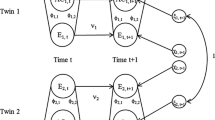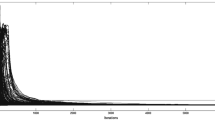Abstract
Non-shared environmental influences show only minimal stability over time prior to adulthood. The long assessment lags (typically 3–5 years) that characterize most longitudinal twin studies, however, make it difficult to interpret these results. To more rigorously evaluate non-shared environmental stability prior to adulthood, we fitted biometric correlated factors models to (1) seven consecutive days of self-reported negative and positive affect in 239 twin pairs aged 16–25 years and (2) seven consecutive minutes of observer rated warmth and control in 687 twin pairs aged 6–10 years. We then empirically examined patterns of etiologic stability over time using a mixed effects analog to the one-way ANOVA. Genetic and shared environmental correlations were found to be highly stable over both days and minutes. By contrast, non-shared environmental correlations decreased monotonically with increasing lag length, and moreover, were small-to moderate in magnitude when examining intervals longer than a few minutes. Such findings imply that the non-shared environment may be comprised primarily of transient and idiosyncratic effects prior to adulthood.

Similar content being viewed by others
Notes
As in Klahr et al. (2013), the final minute of the 8-min interaction was not analyzed since many dyads discontinued the task prior to the full eight minutes.
References
Akaike H (1987) Factor analysis and AIC. Psychometrika 52:317–332
Baker LA, Barton M, Raine A (2002) The Southern California twin register at the University of Southern California. Twin Res 5:456–459
Bartels M, van den Oord EJCG, Hudziak JJ, Rietveld MJH, van Beijsterveldt CEM, Boomsma DI (2004) Genetic and environmental mechanisms underlying stability and change in problem behaviors at ages 3, 7, 10, and 12. Dev Psychol 40:852–867
Burt SA (2009) Rethinking environmental contributions to child and adolescent psychopathology: a meta-analysis of shared environmental influences. Psychol Bull 135:608–637
Burt SA, Klump KL (2013) The Michigan State University Twin Registry (MSUTR): an update. Twin Res Hum Genet 16:344–350
Burt SA, Krueger RF, McGue M, Iacono WG (2003) Parent-child conflict and the comorbidity among childhood externalizing disorders. Arch Gen Psychiatry 60:505–513
Burt SA, McGue M, Iacono WG, Krueger RF (2006) Differential parent-child relationships and adolescent externalizing symptoms: cross-lagged analyses within a twin differences design. Dev Psychol 42:1289–1298
Burt SA, Carter LA, McGue M, Iacono WG (2007a) The different origins of stability and change in antisocial personality disorder symptoms. Psychol Med 37:27–38
Burt SA, McGue M, Krueger RF, Iacono WG (2007b) Environmental contributions to adolescent delinquency: a fresh look at the shared environment. J Abnorm Child Psychol 35:787–800
Burt SA, Barnes AR, McGue M, Iacono WG (2008) Parental divorce and adolescent delinquency: ruling out the impact of common genes. Dev Psychol 44:1668–1677
Burt SA, McGue M, Iacono WG (2009) Non-shared environmental mediation of the association between deviant peer affiliation and adolescent externalizing behaviors over time: results from a cross-lagged monozygotic twin differences design. Dev Psychol 45:1752–1760
Burt SA, McGue M, Iacono WG (2010) Environmental contributions to the stability of antisocial behavior over time: are they shared or non-shared? J Abnorm Child Psychol 38:327–337
Crawford JR, Henry JD (2004) The Positive and Negative Affect Schedule (PANAS): construct validity, measurement properties and normative data in a large non-clinical sample. Br J Clin Psychol 43(3):245–265
Deater-Deckard Kirby, Pylas M, Petrill SA (1997) The Parent-Child Interaction System (PARCHISY). Institute of Psychiatry, London
Dickens WT, Bean C, Turkheimer E (2009) Longitudinal structure of the non-shared environment in children and older adult twins. Paper presented at the 39th Annual Meeting of the Behavioral Genetics Association, Minneapolis, MN
Haberstick BC, Schmitz S, Young SE, Hewitt JK (2006) Genes and developmental stabiltiy of aggressive behavior problems at home and school in a community sample of twins aged 7–12. Behav Genet 36:809–819
Hay DA, McStephen M, Levy F, Pearsall-Jones J (2002) Recruitment and attrition in twin register studies of childhood behavior: the example of the Austrailian Twin ADHD Project. Twin Research 5:324–328
Hopwood CJ, Donnellan MB, Blonigen DM, Krueger RF, McGue M, Iacono WG, Burt SA (2011) Genetic and environmental influences on personality trait stability and growth during the transition to adulthood: a three wave longitudinal study. J Pers Soc Psychol 100:545–556
Klahr AM, Burt SA (2014) Elucidating the etiology of individual differences in parenting: a meta-analysis of behavioral genetic research. Psychol Bull 140:544–586
Klahr AM, McGue M, Iacono WG, Burt SA (2011) The association between parent-child conflict and adolescent conduct problems over time: results from a longitudinal adoption study. J Abnorm Psychol 120:46–56
Klahr AM, Thomas KM, Hopwood CJ, Klump KL, Burt SA (2013) Evocative gene-environment correlation in the mother-child relationship: a twin study of interpersonal processes. Dev Psychopathol 25:105–118
Klump KL, Burt SA (2006) The Michigan State University Twin Registry (MSUTR): Genetic, environmental and neurobiological influences on behavior across development. Twin Res Hum Genet 9(6):971–977. doi:10.1375/twin.9.6.971
Lipsey MW, Wilson DB (2001) Practical meta-analysis, 49th edn., Applied social research methods seriesSage Publications, Thousand Oaks
Little RJA, Rubin DB (1987) Statistical analysis with missing data. Wiley, New York
Matheny AP (1983) A longitudinal twin study of stability of components from Bayley’s Infant Behavior Record. Child Dev 54:356–360
McGue M, Bouchard TJ Jr (1984) Adjustment of twin data for the effects of age and sex. Behav Genet 14:325–343
McGue M, Elkins I, Walden B, Iacono WG (2005) Perceptions of the parent-adolescent relationship: a longitudinal investigation. Dev Psychol 41:971–984
Molenaar PCM, Smit DJA, Boomsma DI, Nesselroade JR (2012) Estimation of subject-specific heritabilities from intra-individual variation: iFACE. Twin Research and Human Genetics 15:393–400
Neale MC, Boker SM, Xie G, Maes HH (2003) Mx: Statistical Modeling, 6th edn. Department of Psychiatry, Richmond
Peeters H, Van Gestel S, Vlietinck R, Derom C, Derom R (1998) Validation of a telephone zygosity questionnaire in twins of known zygosity. Behav Genet 28(3):159–161
Plomin R, Daniels D (1987) Why are children in the same family so different from one another? Behav Brain Sci 10:1–60
Rutter M, Silberg J, O’Connor TJ, Simonoff E (1999) Genetics and child psychiatry: i Advances in quantitative and molecular genetics. J Child Psychol Psychiatry 40:3–18
Sadler P, Ethier N, Gunn GR, Duong D, Woody E (2009) Are we on the same wavelength? Interpersonal complementarity as shared cyclical patterns during interactions. J Personal Soc Psychol 97(6):1005–1020. doi:10.1037/a0016232
Saudino KJ (2005) Behavioral genetics and child temperament. J Dev Behav Pediatr 26(3):214
Turkheimer E, Waldron M (2000) Nonshared environment: a theoretical, methodological, and quantitative review. Psychol Bull 126:78–108
Watson D, Clark LA, Tellegen A (1988) Development and validation of brief measures of positive and negative affect: the PANAS scales. J Pers Soc Psychol 54(6):1063–1070
Wilson DB (2005) Meta-analysis macros for SAS, SPSS, and Stata. http://mason.gmu.edu/~dwilsonb/ma.html. Accessed 22 Jan 2012
Acknowledgments
This study was supported by R01-MH081813 and R01-MH082054 from the National Institute of Mental Health (NIMH) and by R01-HD066040 from the Eunice Kennedy Shriver National Institute for Child Health and Human Development (NICHD). The content is solely the responsibility of the authors and does not necessarily represent the official views of the NIMH, the NICHD, or the National Institutes of Health. The authors thank all participating twins and their families for making this work possible.
Conflict of Interest
S. Alexandra Burt, Ashlea M. Klahr and Kelly L. Klump declare that they have no conflict of interest.
Human and Animal Rights
Assessment and recruitment procedures for both studies were approved by the Michigan State University IRB, and were performed in accordance with the ethical standards as laid down in the 1964 Declaration of Helsinki and its later amendments or comparable ethical standards.
Informed Consent
Informed consent (and when applicable, informed assent) was obtained from all participants.
Author information
Authors and Affiliations
Corresponding author
Additional information
Edited by Yoon-Mi Hur.
Appendix
Appendix
Rights and permissions
About this article
Cite this article
Burt, S.A., Klahr, A.M. & Klump, K.L. Do Non-shared Environmental Influences Persist Over Time? An Examination of Days and Minutes. Behav Genet 45, 24–34 (2015). https://doi.org/10.1007/s10519-014-9682-6
Received:
Accepted:
Published:
Issue Date:
DOI: https://doi.org/10.1007/s10519-014-9682-6




